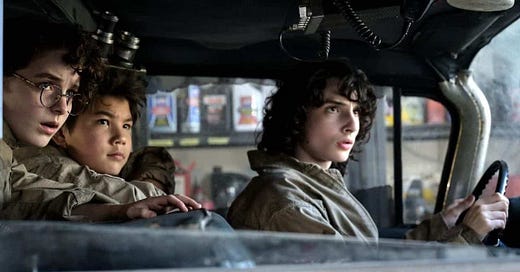Ghostbusters: Afterlife
Jason Reitman's legacy sequel is an emotionally satisfying tribute to his father's original that never feels forced, but a natural progression of the series.
There was a time where “Ghostbusters” was a viable franchise for Sony. Ivan Reitman’s 1984 comedy is still a staple in the horror-comedy genre and the footprint it left on pop culture is still present today.
While the 1989 sequel “Ghostbusters II” didn’t necessarily live up to its larger than life predecessor, it still has its fair share of fans. When Sony tried to reboot the franchise in 2016 with Paul Feig directing and an all-female cast, the studio suffered quite a bit of backlash and while it did receive mostly positive reviews from critics, the audience was not as high on it.
It also didn’t meet the studio’s box office expectations, making the future of the franchise in doubt. That was until in early 2019 when Sony announced that Jason Reitman, director of critically acclaimed films such as “Juno” and “Up In The Air,” would be following in his father’s footsteps and make a true “Ghostbusters III.”
“Ghostbusters: Afterlife” seems like it’s a test on whether or not the last installment soured audience’s taste for the brand or if they’re still up for more ghostbusting. After numerous delays due to the COVID-19 pandemic, Reitman’s follow-up is finally here.
“Ghostbusters: Afterlife” takes us away from the New York setting of previous installments and instead is set in the small town of Summerville, Montana. Single mother Callie (Carrie Coon) has recently been evicted from her home along with her two kids: the insanely smart Phoebe (McKenna Grace), who is interestingly coded as being on the Autism spectrum, and the rebellious and sarcastic Trevor (Finn Wolfhard). The family packs their things and heads to the middle of nowhere town, inheriting the crumbling old home left behind by Callie’s recently deceased father.
While initially reluctant, Phoebe and Trevor quickly adjust to their new life. Trevor takes a job at a local diner to work with his new crush Lucky (Celeste O’Connor) while Phoebe attends summer school taught by the nerdy and lazy Gary (Paul Rudd), who strikes up a romance with Callie. Phoebe learns from her classmate Podcast (Logan Kim), that Summerville is far from your normal small-town, harboring a supernatural secret.
This leads Phoebe to make discoveries about her grandfather’s past and that he may have been… a Ghostbuster. It’s now up to her and Trevor and their newfound friends to save the town and the world from a ghastly apocalyptic event.
“Ghostbusters: Afterlife” is told in quite the unique fashion; it stays true to its ‘80s roots, but almost feels more akin to a classic Amblin film rather than what we’ve come to expect from the franchise. There’s certainly plenty of references made to the original two films (almost too many, but we’ll get to that later), though there is also an unexpected strong emotional core to the film that many might not expect.
Reitman puts his own unique spin on the latest entry, the film feels genuine. Unlike a lot of the other ‘legacy reboots/sequels’ to beloved 70s/80s/90s franchises, the story of “Ghostbusters: Afterlife” never feels forced, but a natural progression of the series.
Keeping with the 80s flavor, “Afterlife” has an impressive amount of practical effects or CGI that is strikingly similar to what came before. It’s cartoonish in a way that is intentional, it’s never too spooky, but instead has that camp feel that made the original film (and the sequel) work so well.
Reitman never feels as if he is forcing in modern references; sure, there’s a character named Podcast and in the first 10 minutes Wolfhard’s Trevor complains about not receiving ‘any bars’ on his phone, but outside of that it maintains a warmly nostalgic atmosphere. One that isn’t afraid to put kids in danger or throw out a couple of jokes that might go over kids heads.
The cast is where the film really shines, especially with Grace as Phoebe, the true lead of the film. At a young age Grace has already pumped out quite the resume across a variety of genres, but her work here might be her finest hour. She brings a quirky charm to the role that’s hard to resist and her deadpan delivery is a highlight of the film.
Kim’s Podcast is another standout, playing the role similarly to how Dan Aykroyd played Ray Stanz. Coon and Rudd are delightful to watch as well, despite not getting as much to do as their younger co-stars, but their presence adds another layer of comfort to the film.
Wolfhard and O’Connor are serviceable in their roles, but the script unfortunately doesn’t give them much personality other than being “the older kids who get wrapped up in their young friends’ adventure.” Of course, there’s plenty of cameos throughout, some expected and some unexpected surprises.
While much of the film feels from the heart and isn’t too focused on creating as big of a scale than the other entries, “Afterlife” at times relies a little bit too much on callbacks which may take some out of the movie. They feel almost like a studio note, something that was slid in last minute. While it does not get as heavy-handed or eye-rolling as the 2016 remake’s attempts at Easter eggs, it doesn’t feel nearly as natural as the rest of the film.
“Ghostbusters: Afterlife” is a pleasant surprise and one that will make for a perfect family viewing over the Thanksgiving holiday. It’s endearing, sweet, comical and a whole lot of fun.





